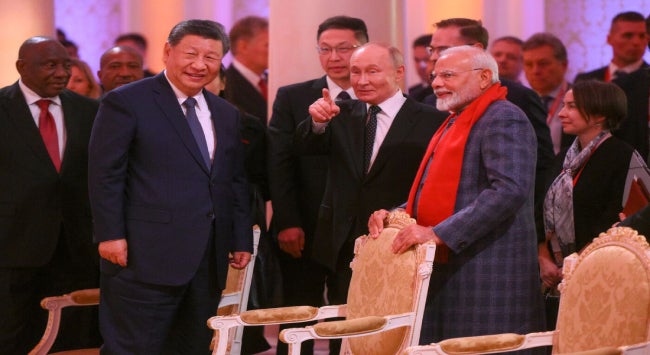Summary
Indian Prime Minister Narendra Modi’s China policy over the past decade reveals a cyclical dynamic characterised by alternating phases of competition-cooperation(coopetition). This pattern highlights the significant influence of the interplay between the “positive” aspects of economic cooperation and the “negative” aspects arising from China-India border conflicts. The underlying cause of this oscillation lies in the shifts in strategic perception, which encompass both an evolving understanding of the strategic environment and India’s own role and opportunities.
During the 16th BRICS Summit from 22 to 24 October 2024, Chinese President Xi Jinping and Indian Prime Minister Narendra Modi held a meeting in Kazan. On the same day, India issued a statement announcing that both sides had reached an agreement on the disputed Himalayan border, with plans for joint patrols. This agreement not only marks the end of a four-year military standoff but also symbolises a significant thaw in Indian-China relations. This recent development reveals the volatility of India’s policy towards China – shifting from engagement to strained relations, followed by adjustment, renewed conflict and now a resumption of engagement, displaying a clear cyclical fluctuation.
Looking back at history, when Modi first came to power in 2014, his ‘hometown diplomacy’ demonstrated a personal gesture of goodwill. In response, Modi was soon invited to visit Xi’s hometown of Xi’an. At the same time, high-level exchanges between China and India intensified. Both countries embraced the label of the ‘Dragon and Elephant Dance’ and they signed multiple agreements across fields such as economy, technology and culture, fostering substantial progress in bilateral relations.
As China put forward the Belt and Road Initiative (BRI) and increased its investments in South Asian countries like Sri Lanka and the Maldives, while advancing connectivity through the China-Pakistan Economic Corridor, the Modi government gradually shifted from its initial friendly stance towards China, showing clear signs of tension and estrangement. At the Raisina Dialogue in 206, India’s External Affairs Minister S Jaishankar remarked that the BRI had “become a stage for contemporary geopolitics”. The Doklam crisis, which erupted between June and August 2017, further triggered confrontation and conflict in India’s China policy, pushing bilateral relations into a shadowy and low phase. Political trust between the two nations significantly declined, and India became increasingly wary of China’s intentions and actions in international affairs, frequently voicing dissatisfaction with Chinese policies on various international platforms. At the same time, India strengthened its cooperation with countries like the United States (US), Japan and Australia, aiming to counterbalance China’s global influence.
Despite political and military differences, India and China have demonstrated renewed willingness to cooperate in the economic sector. According to data from India’s Ministry of Commerce and Industry, China was India’s largest import partner in 2018, with imports reaching US$73.74 billion (S$99.54 billion), while bilateral trade between the two countries amounted to US$95 billion (S$128.25 billion), reflecting a 13.2 per cent increase, compared to 2017. The two sides continued dialogue through mechanisms such as the Joint Economic Group, the Economic and Trade Partnership Council, the Trade and Services Agreement and the Trade Investment Strategy. Additionally, they signed several cooperation agreements across various economic fields, including enhancing infrastructure development, expanding technological cooperation and promoting bilateral investment. The Indian government also invited Chinese companies to participate in its national initiatives such as ‘Make in India’ and ‘Digital India’, seeking further economic collaboration opportunities.
Building on earlier efforts to ease tensions through formal and informal diplomatic channels, such as the Wuhan and Chennai summits, India and China tried to manage their strained relationship. However, with the border issue unresolved and influenced by external factors, Indian-China relations, once again, became tense in 2020. Following the Galwan Valley border clash, anti-China sentiment surged within India. In response, Modi increased military deployments in the border areas, reinforced defence infrastructure, boosted defence spending and upgraded India’s defence partnership with the US. After a prolonged standoff, India and China have, once again, resumed dialogue, leading to agreements and solutions.
Modi’s shift in policy towards China reflects an adjustment in India’s strategic perception. In the context of US-China strategic competition, India aims to be the “leader” of the Global South, a “balancer” in the trilateral relations between the US, China and India, and a “defender” in border conflicts. Specifically, the Modi government’s strategic perception is evident in several aspects. Firstly, in terms of recognising the strategic environment, US-China competition, along with the Indo-Pacific strategy, has provided India with new strategic opportunities and dividends. During Modi’s tenure, India has enhanced its position in global and regional affairs by deepening cooperation with the US. Secondly, regarding the recognition of its own role, India has shifted from being seen as a “major Asian power” to pursuing the status of a “global leadership power”. While maintaining strategic autonomy, India seeks decision-making independence through multi-faceted alliances and issue-oriented collaborations, aiming to secure an international status commensurate with its capabilities in a multipolar world. Thirdly, in terms of recognising strategic opportunities, under Modi’s leadership, India perceives that with the clear delineation of US-China strategic competition, the window of strategic opportunities has actually been extended compared to 2012, providing India with “unprecedented” strategic space.
Indian-China relations have repeatedly oscillated between cooperation and conflict, creating a cyclical dynamic. This cycle not only reveals the complexity of the relationship between the two countries but also indicates that multiple challenges and uncertainties will continue to confront them in the future.
. . . . .
Ms Bian sai is an Academic Visitor at the Institute of South Asian Studies (ISAS), an autonomous research institute at the National University of Singapore (NUS). She can be contacted at isav34@partner.nus.edu.sg. The author bears full responsibility for the facts cited and opinions expressed in this paper.
-
 More From :
More From :
-
 Tags :
Tags :
-
 Download PDF
Download PDF



